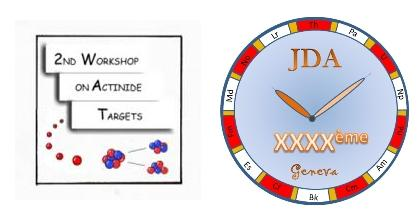Speaker
Ms
Anna Maria Adamska
(AGH University of Science and Technology)
Description
Hydrogenation is a powerful tool capable of changing both crystal structure and magnetic properties of intermetallic compounds. The hydrogen absorption of UTSi compounds (T = Co, Pd, Ni) compounds obtained by direct synthesis from intermetallic precursors at high H2 pressure (pH2 > 100 bar) leads to a notable lattice expansion and an increase of respective magnetic ordering temperatures [1,2]. This opens even better possibility for fine tuning of magnetism by H doping in UTGe compounds, replacing Si by larger Ge. The effect of hydrogenation is already known for U(Fe,Rh)Ge compounds [3]. In the present work, the hydrogenation was performed for UTGe series with T = Rh, Pd, Ir and Ni by applying the highest hydrogen pressure (pH2 ~60 bar) and temperature cycling up to T = 773 K. Most of the UTGe compounds crystallize in the orthorhombic TiNiSi-type of structure (space group Pnma). In the case of a-hydride of URhGe obtained at slightly lower pressure, the crystal structure remains orthorhombic with the volume expansion of 1.0 %. The value of TC was difficult to determine due to apparent inhomogeneity of the system. However, one can say that TC extends to substantially higher values than for URhGe (9 K) [3]. By applying the highest pH2 we obtained another a-hydride of URhGe with 0.3 H/f.u. and the volume expansion of 1.3 %. Unlike URHGeH0.1, URhGeH0.3 is magnetically homogeneous, the value of TC of 17 K was determined from the Arrott plot (Fig. 1.). The spontaneous magnetization increases from 0.14 mB/U-atom for the parent compound to 0.34 mB/U-atom for the hydride (both fixed powder data) at T = 2 K.
Fig. 1. Arrott plot for URhGeH0.3.
The hydrogenation of UPdGe and UIrGe at pH2 ~ 160 bar causes the volume expansion of 0.5 % and 0.7 %, respectively, preserving the TiNiSi type of structure. The pure UPdGe undergoes two phase transitions FM–AFM–PM with the phase transitions at TC ~ 30 K and TN ~ 50 K. Hydrogen absorption in UPdGe does not change TN, but it leads to a suppression of TC down to 26 K (Fig. 2.). In the case of UIrGe, we observe the antiferromagnetic ground state (TN ~ 16 K) [4] transformed into ferromagnetic one in the a-hydride (UIrGeH0.1). Such a transition was revealed by a well-pronounced but broad peak of ac susceptibility with maximum around 30 K (Fig. 2.). The spontaneous magnetization corresponds to 0.29 mB/U-atom. The onset of ferromagnetism can be assumed around 40 K, but the system looks magnetically inhomogeneous. A single-phase hydride of UNiGe with high H occupancy (1.2 H atoms per formula unit) was synthesized at the highest H2 pressure. After hydrogenation the orthorhombic symmetry of the parent compound is lifted to hexagonal (ZrBeSi-type) and the unit cell volume expands by 7.6 %. UNiGe exhibits two antiferromagnetic phase transition, one below below TN ~ 42-44 K and the second one just below 50 K [4], whereas UNiGeH1.2 is a ferromagnet with TC below 100 K (Fig. 3.) and the spontaneous magnetization around 0.40 mB/U-atom. The results of the crystal structure refinement and the fitting parameters of the modified Curie-Weiss law for UTGe and its hydrides are given in Table 1.
Fig. 2. ac susceptibility- ac(T) (real and imaginary part) for UPdGe, UPdGeH0.1 and UIrGeH0.1.
Fig. 3. Temperature dependence of the magnetic susceptibility for UNiGe and its hydride measured in moH = 2 T.
Table 1. Comparison of crystal structure and magnetic susceptibility parameters of UTGe and its hydrides.
It gives lattice parameters a, b, and c, volume per formula unit, relative increase of volume with respect to UTGe (DV/V), inter-uranium spacing dU-U, the ordering Curie temperature TC and parameters of the fit of the susceptibility in the modified Curie-Weiss regime (high T): effective moments meff, paramagnetic Curie temperature Op, and the T-independent term . *- data from Ref. [4].
References
[1] K. Miliyanchuk et al., J. Alloys Comp. 383, 103-107 (2004).
[2] A. V. Kolomiets et al., Phys. Rev. B 66, 144423 (2002).
[3] A. M. Adamska at al,. Magnetism in hydrogenated UTGe compounds, IOP Conf. Proc 2010, in press.
[4] R. Troc, V.H. Tran, J. Magn. Magn. Mater. 73, 389-397 (1988).
Primary author
Ms
Anna Maria Adamska
(AGH University of Science and Technology)
Co-authors
Mr
Jiří Pospíšil
(Charles University)
Dr
Ladialv Havela
(Charles University)
Dr
N.-T.H. Kim-Ngan
(Pedagogical University)




